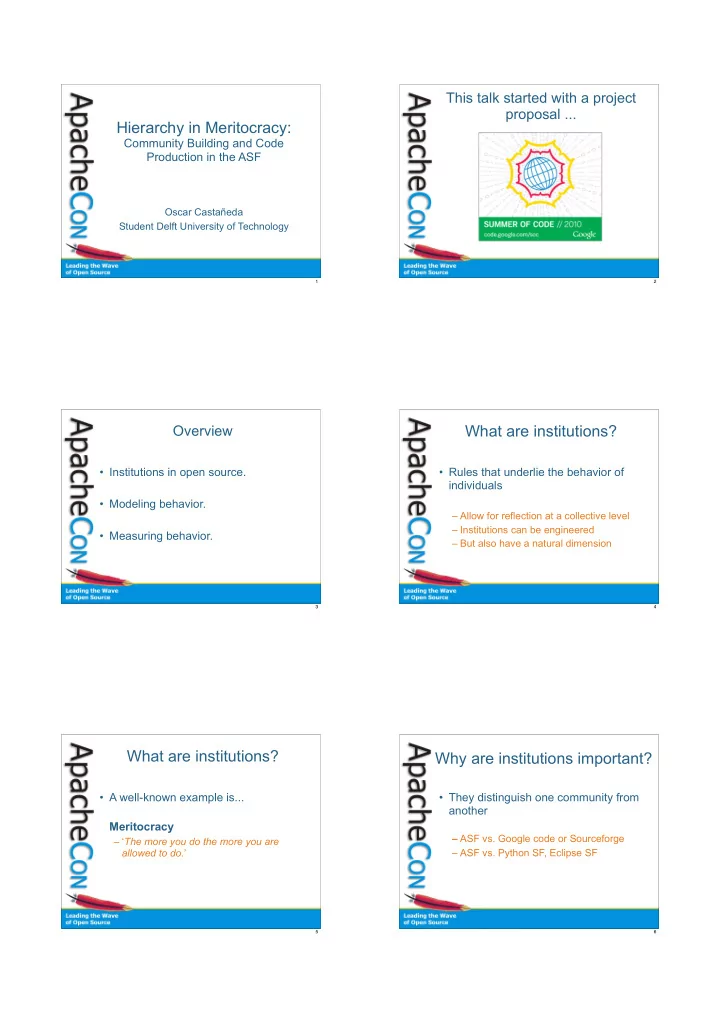

This talk started with a project proposal ... Hierarchy in Meritocracy: Community Building and Code Production in the ASF Oscar Castañeda Student Delft University of Technology 1 2 What are institutions? Overview • Institutions in open source. • Rules that underlie the behavior of individuals • Modeling behavior. – Allow for reflection at a collective level – Institutions can be engineered • Measuring behavior. – But also have a natural dimension 3 4 What are institutions? Why are institutions important? • A well-known example is... • They distinguish one community from another Meritocracy – ASF vs. Google code or Sourceforge – ‘ The more you do the more you are – ASF vs. Python SF, Eclipse SF allowed to do .’ 5 6
Why are institutions important? Why are institutions important? • Useful in decision-making • Delimiting the boundaries of an open source community ... – Graduation of an incubator project – Assigning roles – Individuals co-author source code files – Delimiting the boundaries of an open – The resulting network delimits the source community community 7 8 Modeling behavior Modeling behavior • Needed for deeper understanding of • We have a network of file co-authorship behavior ... – Model institutions as dimensions in that social network – How organized? – Network-level measures – Influence on code production? 9 10 Modeling behavior Modeling behavior HTTP Server Tuscany (2009) (2009) 11 12
Modeling behavior Modeling behavior Hadoop • What aspects can be modeled? (2009) – Connectedness – Asymmetry – Redundancy 13 14 Modeling behavior Modeling behavior • Related institutions • What other aspects can be modeled? – Clustering – Collective choice – Average distance – Conflict resolution – Nested enterprise 15 16 Modeling behavior Measuring behavior • However, no related institutions • Institutionalized behavior – Self-organization – Follows rules or norms • Self-organized behavior • But interesting phenomena – Emergent – Small world networks • High clustering coefficient • Small average distance 17 18
Measuring behavior Measuring behavior • Sample: ~260 observations • Measures of hierarchy – Dump of ASF Subversion repository – graph hierarchy ( asymmetry ) • http://svn-master.apache.org/dump – graph connectedness ( connectedness ) – All ASF communities from 2004-2009 – graph efficiency ( redundancy ) • Tools – Data mining: SVNPlot (version 0.7.0) – SNA: CMU’s *ORA, Gephi – Statistics: R and Stata 19 20 Measuring behavior Measuring behavior • Graph hierarchy (asymmetry) • Graph hierarchy (asymmetry) 21 22 Measuring behavior Measuring behavior • Graph connectedness (connectedness) • Graph connectedness (connectedness) 23 24
Measuring behavior Measuring behavior • Graph efficiency (redundancy) • Graph efficiency (redundancy) 25 26 Measuring behavior Measuring behavior • Clustering coefficient • Measures of clustering – clustering coefficient – average distance 27 28 Measuring behavior Measuring behavior • Clustering coefficient • Average distance 29 30
Measuring behavior Conclusions • Average distance • Modeling and measuring behavior gives insights into code production • Some institutions have a negative impact on code production • Other institutions have a positive influence • Self-organization also plays a role 31 32 Future Directions QA / Discussion • Propose an Apache Lab • Develop an Apache Agora script extension for SVNPlot • Recommendation mining using Apache Mahout: recommend files to developers based on behavior 33 34 Acknowledgements • Charel Morris, Stone Circle Productions. • Nitin Bhide, Founder of SVNPlot and Thanks. GSoC mentor. • Google’s Open Source Programs Office. 35 36
Recommend
More recommend